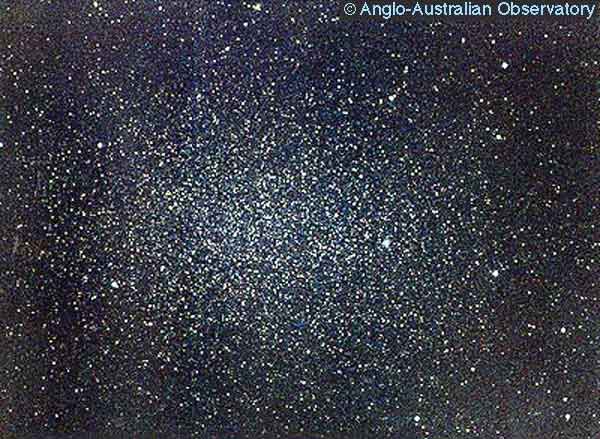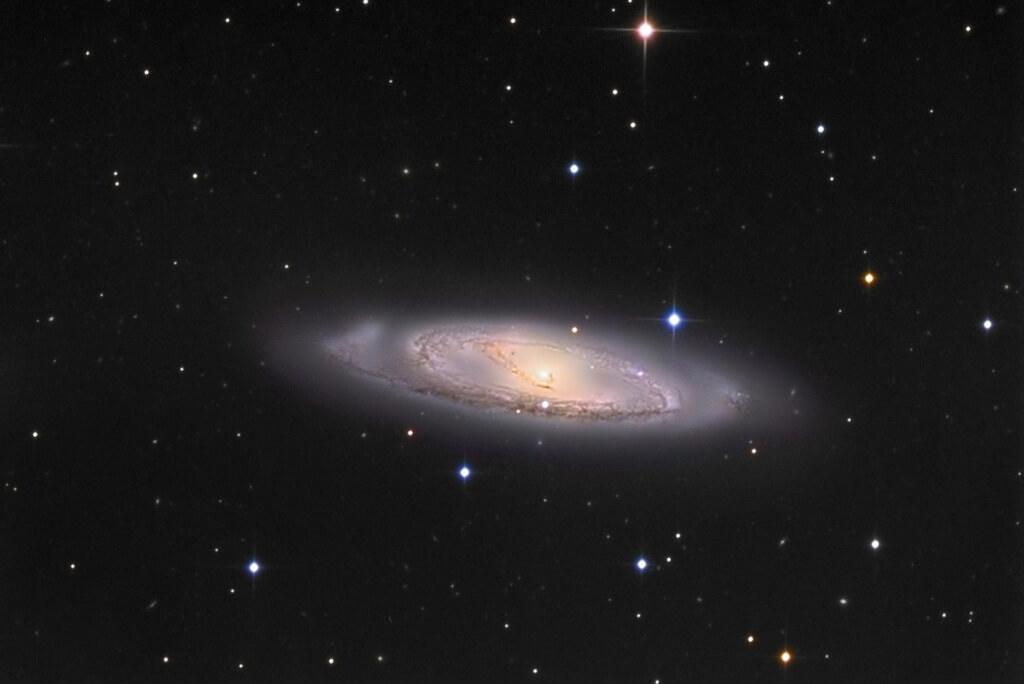By now, we’ve spent a heck of a lot of time exploring spiral galaxies.
It makes sense–they’re certainly the most photogenic. Seriously. Do me a favor and do a quick Google search for galaxies. When I did, nearly all the results were spirals…even though spirals are not the most common galaxies in the universe.
There is, of course, another reason we’re so familiar with spirals right now. We dipped our toes in the waters of studying galaxies by exploring our own home galaxy–a reasonable starting point. Our Milky Way just happens to be a spiral.
Well…it doesn’t “just happen” to be a spiral. But we’ll get to the reasons for that…
For now, let’s take a dive into all the different types of galaxies.
Let’s start with the most common galaxies…

There’s actually a couple of different galaxies in this photo–including one that looks just a little bit spiral-ish, judging by the trail of dust visible in its profile.
But the galaxy that dominates this view is of a shape you might not be very familiar with. This, people, is an elliptical galaxy.
When I first learned about elliptical galaxies, I found it a bit confusing. I thought, “Isn’t an ellipse like a circle–that is, mathematically, a circle is a special case of an ellipse? And spiral galaxies have circular (or elliptical) disks. So what the heck is the difference between a spiral galaxy and an elliptical galaxy?”
No need for you to face the same confusion I did.
Here is a spiral galaxy and an elliptical galaxy, viewed side by side.
Notice how a spiral, viewed in profile, looks like a disk–like a frisbee, or a pizza?
No matter what angle you look at an elliptical from, it will never appear like a disk. It’s the same in all dimensions: a big, uniform ball of stars. The closest ellipticals get to being flat is when they appear a bit squashed, like an American football or a smushed loaf of bread.
The crux: Spirals are disk galaxies. They’re only circular in one dimension. Elliptical galaxies are not disk galaxies. They’re spherical blobs.
Elliptical galaxies are a very general classification–ellipticals themselves can vary a lot.
Ok…I guess that doesn’t really look like a whole lot of variation. They’re all blobs!
But the numerical index you see above, from E0 to E7 (“E” standing for elliptical), tells you just how round or squashed/elongated an elliptical is. E1s, like the giant elliptical galaxy Messier 87, are quite round. E7s, on the other hand, are ridiculously stretched out–even more than an American football.
And then, of course, you’ve got variation in the sizes of galaxies. M87 is huge. But the Leo 1 dwarf, on the other hand–a satellite of the Milky Way–barely even looks like a galaxy. It’s barely larger than a globular star cluster, an object found within galaxies.
(Yes, I know, I’ve hyped and hinted at the mysterious story of globular clusters for ages–someday, I’ll dedicate a post to them!)

Here’s the Leo 1 dwarf for ya. See what I mean? Look how spread out its stars are. Sure enough, though, it’s an elliptical galaxy.
Elliptical galaxies have no visible gas or dust and no hot, bright stars. That is to say…they have no young stars and no ingredients for star formation.
That’s no surprise–the spiral arms of spiral galaxies, practically by definition, are home to all the star-forming ingredients and active star-forming regions we could possibly want. The lack of young objects in elliptical galaxies is further evidence that, in order to form stars, you need spiral arms.
Explains why our home is a spiral galaxy. Our solar system is “only” 4.6 billion years old. On an astronomical timescale, it’s very young. Such a young star system would not be found in an elliptical galaxy.
Speaking of spiral galaxies…
The central image here is the Andromeda Galaxy, our nearest intergalactic neighbor–and something I’ll be devoting some more attention to later on! Andromeda is probably one of the most photogenic galaxies you’ll ever see, both because it has a beautiful, dusty spiral pattern and because its proximity and sheer size make it easy to photograph.
But how about those other ones?
To further classify spiral galaxies, we use a scale of “a” through “c” to indicate the size of the central nucleus and the amount of gas, dust, and hot, bright stars. We use a capital “S” to indicate the galaxy is a spiral. A capital “B” indicates if the galaxy has a bar-shaped nucleus.
At the top right is NGC 3623, what’s known as a class Sa galaxy. That is, it’s a spiral–“S”–and it has a large nucleus, less gas and dust, and fewer hot, bright stars than other spirals.

At the other end of the scale is NGC 2997, an Sc galaxy. It’s the one in the middle on the bottom. Its nucleus is small, it is filled with hot, bright stars, and it has lots of gas and dust.

In the mid range of the scale, we have NGC 3627, the galaxy at the bottom left. It is classified as “Sb.” That means it has a mid-sized nucleus, and it’s in the middle on everything else–gas, dust, and hot, bright stars.

However…is there anything else you notice about NGC 3627, directly above?
Unlike NGC 2997–the previous image–NGC 3627 above has a distinctly elongated nucleus. This is what we call a bar, and the galaxy as a whole is considered a barred spiral galaxy. NGC 3627 is fully classified as SBb. There’s the capital B, for the bar.
The bar in NGC 3627 is fairly distinct, but bars get much more spectacular…
Here’s some…ahem…particularly distinct barred spirals. Crazy, huh?
The Milky Way itself is a barred spiral–as far as we can tell. It’s a bit hard to look inside our own galaxy since we have to look directly through all the gas and dust of the spiral arms, though. Imagine trying to figure out if this distant galaxy actually has a bar-shaped nucleus…

I don’t know about you, but I can barely see the nucleus in the first place.
Don’t get me wrong. This are visual-wavelength images. Imaging and research in other wavelengths of light, particularly radio wavelengths, is a whole lot more revealing.
Every photon of light that galaxies emit is useful in figuring out their histories–it doesn’t make sense to confine observations to the narrow range of light that humans happened to evolve to see.

That’s how we can study the nucleus of our own galaxy–it’s almost only visible in radio wavelengths, with some exceptions. Non-visible wavelengths are useful for mapping otherwise invisible structures of distant galaxies, too. So it could be entirely possible to figure out if this edge-on spiral has a bar-shaped nucleus.
Definitely more difficult than looking down on spirals from “above” or “below,” though.
On the whole, the Milky Way is classed SBbc: a barred spiral midway between Sb (mid range of bright stars, gas, dust, and nucleus size) and Sc (the extreme end with a small nucleus and numerous dust, gas, and bright stars).
But, moving on…anyone notice just how concentrated the dust is in that edge-on spiral above?
Up above was NGC 4013, and it’s definitely one of the more photogenic edge-on spirals, with its dust quite…ahem…apparent. And I’ll show you something even crazier…

NGC 2207 (the larger one on the left) and IC 2163 are, in fact, colliding. From Earth, we get to watch their gravitational interactions in extreme slow-mo.
Seriously, I mean extreme slow-mo. Very rarely does anything in the cosmos change fast enough for humans to notice. But, by observing different objects spread through the galaxy in different stages of the same event and connecting the dots, we can piece together a story.
(I described a particular case of this technique in a post on unique neutron stars.)
But that’s not why I’m showing you this.
Look closely at the place where the larger galaxy on the left (NGC 2207) crosses in front of IC 2163. Do you see that trail of dark dust that follows the curve of NGC 2207’s bottommost spiral arm?
That is dust from NGC 2207, silhouetted by the background light from the more distant stars of IC 2163.
Not all disk galaxies have dust, though.

NGC 5308 is what we call a lenticular galaxy–a disk galaxy with no visible gas or dust and no hot, bright stars.
This galaxy would seem to have the ingredients of an elliptical galaxy–its uniform appearance, its lack of young objects or star-forming material. But there’s no mistaking its disk shape. Clearly, it doesn’t qualify as an elliptical. But it’s not much of a spiral, either.
Lenticulars are classified S0. We will most definitely be exploring them later on, when we delve into galactic histories, interactions, and what they can tell us about the universe itself.
But for now…on to our last attraction, irregular galaxies.
I would be remiss not to include the Milky Way’s nearest satellites as representatives.
I last showed these off in my post on how the Milky Way formed. Once again, my southern hemisphere readers might recognize these irregular galaxies as the Large and Small Magellanic Clouds.
Sorry, northern hemisphere people–these aren’t visible at our latitudes.
Irregular galaxies are classified “Irr”. And as you can probably see from the Magellanic Clouds above…they really don’t have much of a defined shape at all.
I mean…that kind of explains why we call them irregular.
Here’s a more distant example of an irregular galaxy–IC 2574, colloquially known as Coddington’s Nebula.

These intergalactic clouds of stars look more like star clusters or nebulae than full galaxies. But they are galaxies in their own right.
They’re made up of a chaotic mix of gas, dust, and stars. Like spiral galaxies, they’re home to active star formation.
You can always tell stars are being born by the bright, blue-tinged stars and clumps of pink gases (emission nebulae)–such as the Tarantula Nebula in the Large Magellanic Cloud.
That’s no surprise to me, especially considering the Magellanic Clouds. After all, both are interacting gravitationally with the much larger Milky Way–and these aren’t exactly solid objects we’re talking about. Galaxies’ stars and dust are bound in the first place by gravity. Gravitational interactions can wreak havoc on a galaxy’s structure.
And those same gravitational perturbations can easily collapse molecular clouds into protostars.
Now that we’re familiar with the different classifcations of galaxies, it’s time to dive even deeper–into just what they’re made of, coming up next week!










